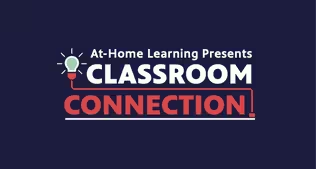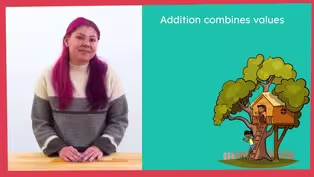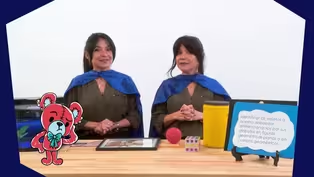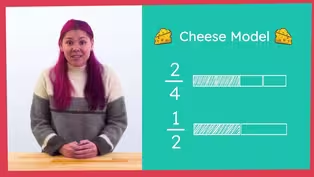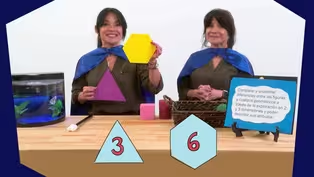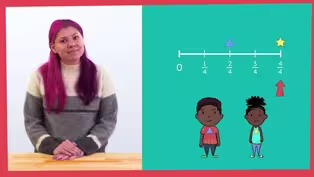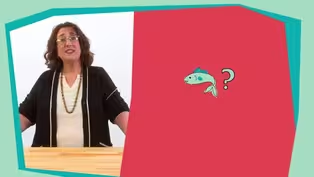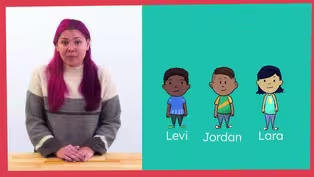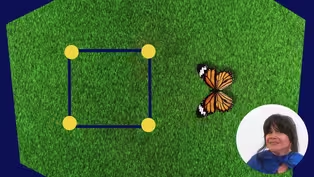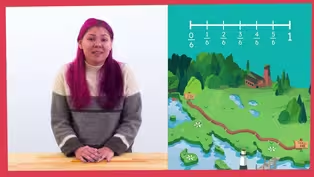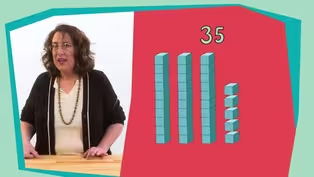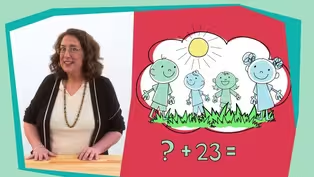
Episode 9 | Math Lessons
3/1/2021 | 28m 46sVideo has Closed Captions
Math lessons for early learners, led by NC teachers.
The first lesson (aimed at PreK-K learners) helps students learn how to count to 100. The second lesson (aimed at 1st-2nd graders) helps learners recognize and combine groups of numbers. Classroom Connection is your At-Home Learning companion where children love to learn. All lessons are led by NC educators.
Problems playing video? | Closed Captioning Feedback
Problems playing video? | Closed Captioning Feedback
At-Home Learning Presents: Classroom Connection is a local public television program presented by PBS NC

Episode 9 | Math Lessons
3/1/2021 | 28m 46sVideo has Closed Captions
The first lesson (aimed at PreK-K learners) helps students learn how to count to 100. The second lesson (aimed at 1st-2nd graders) helps learners recognize and combine groups of numbers. Classroom Connection is your At-Home Learning companion where children love to learn. All lessons are led by NC educators.
Problems playing video? | Closed Captioning Feedback
How to Watch At-Home Learning Presents: Classroom Connection
At-Home Learning Presents: Classroom Connection is available to stream on pbs.org and the free PBS App, available on iPhone, Apple TV, Android TV, Android smartphones, Amazon Fire TV, Amazon Fire Tablet, Roku, Samsung Smart TV, and Vizio.
Providing Support for PBS.org
Learn Moreabout PBS online sponsorshipMore from This Collection
Math lessons for early learners, led by NC teachers.
Video has Closed Captions
Math lessons for early learners, led by NC teachers. (28m 46s)
Video has Closed Captions
Math lessons for early learners, led by NC teachers. (28m 46s)
Video has Closed Captions
Math lessons for early learners, led by NC teachers. (28m 46s)
Video has Closed Captions
Math lessons for early learners, led by NC teachers. (28m 46s)
Video has Closed Captions
Math lessons for early learners, led by NC teachers. (28m 46s)
Video has Closed Captions
Math lessons for early learners, led by NC teachers. (28m 46s)
Video has Closed Captions
Math lessons for early learners, led by NC teachers. (28m 46s)
Video has Closed Captions
Math lessons for early learners, led by NC teachers. (28m 46s)
Video has Closed Captions
Math lessons for early learners, led by NC teachers. (28m 45s)
Video has Closed Captions
Math lessons for early learners, led by NC teachers. (28m 46s)
Video has Closed Captions
Math lessons for early learners, led by NC teachers. (28m 45s)
Video has Closed Captions
Math lessons for early learners, led by NC teachers. (28m 46s)
Providing Support for PBS.org
Learn Moreabout PBS online sponsorship[cheerful upbeat music] ♪ - Hi friends.
Welcome to another awesome day of Classroom Connection.
I'm Mr. R and I am so glad to see you today.
Did you know that this space right here, this space right here is magical?
Yeah, it's true.
And you know why?
Because this is where learning happens, and learning is the most magical thing ever.
I love learning new things.
Do you?
I know you do.
Today is going to be so much fun.
We're gonna learn about math, as well as arts, and science.
But mostly we're gonna have some fun.
So let's jump in.
- Good morning, super learners.
I'm Ms. M. I'm so glad you're joining me.
Are you ready for a math adventure today?
Well, let's get started with the song.
♪ Hello super learners how are you ♪ ♪ Hello super learners how are you ♪ ♪ I'm so glad you're here today ♪ ♪ And I hope you feel the same ♪ ♪ Hello super learners how are you ♪ How are you today?
I feel great today and I really hope you do too.
Let's get started with some math power warmups.
Counting up to 20.
Are you ready?
Here we go.
One, two, three, four, five, six, seven, eight, nine, 10 11, 12, 13, 14, 15, 16, 17, 18, 19, 20.
That was fun.
Awesome.
Awesome sauce super learners.
Let's count up to 20 one more time.
And this time we're gonna snap count.
One, two, three, four, five, six, seven, eight, nine 10.
Let's keep going.
11, 12, 13, 14, 15, 16, 17, 18, 19, 20, yes, super learners are the best.
I'm getting warmed up.
Are you?
How about one more time counting to 20?
But this time in Spanish.
[speaking in a foreign language] Amazing super learners.
Now we've counted to 20 in three different ways.
And it's time to name our colors.
Let's review our colors.
Rojo, red.
[speaking a foreign language] orange.
[speaking a foreign language] yellow.
[speaking a foreign language] green.
[speaking a foreign language] blue.
[speaking a foreign language] purple.
[speaking a foreign language] brown.
[speaking a foreign language] black.
[speaking a foreign language] white.
And [speaking a foreign language] gray.
Look for these colors in the world today.
One more warmup.
Here we go.
Let's play the shape game.
You will see a shape and then you will say its name.
[speaking a foreign language] square, [speaking a foreign language] circle, [speaking a foreign language] triangle, [speaking a foreign language] rectangle, [speaking a foreign language] rhombus, trapezoid, trapezoid, [speaking a foreign language] hexagon, [speaking a foreign language] cube, [speaking a foreign language] cone, [speaking a foreign language] cylinder, [speaking a foreign language] spear.
All warmed up?
Then it's time for... Our math mission of the day.
Let's check with sparkles the fish to see what our math mission is today.
Dear super learners, your mission today is become super counters.
Count to 100 in two different ways.
So today we will count to 100 in two ways.
Well super learners, I know we can do this mission.
Capes on, math power up, let's go.
Here is a hundreds chart.
This math tool can help us accomplish our math mission.
Let's start by counting all the way to 100 by ones.
That means we will say each number in order all the way to 100.
Ready, set, math power up.
One, two, three, four, five, six, seven, eight, nine, 10, 11, 12, 13, 14, 15, 16, 17, 18 19, 20, 21, 22, 23, 24, 25, 26, 27, 28, 29, 30, 31, 32, 33, 34, 35, 36, 37, 38, 39, 40, 41, 42, 43, 44, 45, 46, 47, 48, 49, 50, 51, 52, 53, 54, 55, 56, 57, 58, 59, 60, 61, 62, 63, 64, 65, 66, 67, 68, 69, 70, 71, 72, 73, 74, 75, 76, 77, 78, 79, 80, 81, 82, 83, 84, 85, 86, 87, 88, 89, 90, 91, 92, 93, 94, 95, 96, 97, 98, 99, 100.
Do you hear that?
Wow!
Amazing super learners.
We just counted to 100 one way.
We are halfway through our mission.
I wonder what another way to count to 100 is?
But first it's time for our math movement break.
Let's exercise our numbers counting down from 10 for inspiration.
Are you ready to move your body to each number?
Let's go.
Math power up.
10 twists.
One, two, three, four, five, six, seven, eight, nine, 10.
Nine hops.
One, two, three, four, five, six, seven, eight, nine.
Eight arm circles.
One, two, three, four, five, six, seven, eight.
Seven knee bends.
One, two, three, four, five, six, seven.
Six arm stretches.
One, two, three, four, five, six.
Five knee raises.
One, two, three, four, five.
Four side bends.
One, two, three, four.
Three toe raises.
One, two, three.
Two head nods.
One, two.
And one big jump.
One!
That was fun counting down from 10, but we are running out of time.
Can we think of a second way to count to 100?
Oh, that's it.
We can count to 100 by tens.
Look at the chart.
At the end of each row is a 10.
If we count by tens, we can accomplish our mission on time.
Let's do it, super learners.
10, 20, 30, 40, 50, 60, 70, 80, 90, 100.
Wait, we did it.
We counted to 100 by tens.
Let's check back with sparkles the fish.
Mission complete.
We counted to 100 in two ways.
Congratulations, super learners.
You used your math powers and completed the mission.
What is it time to do?
Let's review.
We can count by ones and by tens to get all the way to 100.
We know that when we count, we have to count in the right order.
Practice counting today.
You can share your math power by showing it to someone.
Thank you, super learners for going on a math mission with me today.
Sparkles, thanks you too.
Remember, you have the power to be super at math.
Adios, goodbye math power out.
- Well, just as important as learning math and literacy is learning to express yourself through art.
When I'm feeling frustrated or disappointed I can always feel better if I write down a song or paint a picture.
Do you have a favorite type of art that you like to make?
It could be making up a dance or taking a picture with a camera or singing.
We have a super cool video about making art that I think you're going to love.
- [Narrator] How to animate with sticky notes.
Here's one I did earlier of a frog.
You can see, you can just flip through all the pictures and it looks like he's moving.
You're gonna need sticky notes, something to draw with.
And some creativity.
Here's a UFO I drew, gliding through the air.
So first you're gonna need your blank, sticky note pad.
And you're gonna wanna go to the last page of the book.
Draw something nice and dark there so that you'll be able to see it on the next page.
I always like to draw a couple of images and just trace over them in one spot.
So the viewer knows what to expect as the flip-books flip very quickly.
So I'm just gonna go ahead here and start drawing each picture.
I'm gonna be drawing a classic bouncing ball going up and down.
And see it squashes on the ground, and starts flying back up.
And then I'm almost done, just a couple more.
And now let's flip.
Perfect.
And if you have any tape on hand, I always like to take the spine of my book in case I wanna add or take out pictures.
I can always just tape it back together and keep it really strong and flip, flip, flip.
- Today's affirmation is I honor my body.
Say it with me.
I honor my body.
I honor my body.
I honor my body.
- What up, cool cats?
Did you know that there are 293 ways to make change for a dollar?
Yeah.
Math helps you make change for a dollar and count the coins you might've found between the couch cushions.
So let's start your math lesson now.
And see what we can learn.
- Hi friends.
My name is Dawn and I am so happy to be here with you today.
This is my friend, Splat and he is going to help me today with some math fun.
We call him Splat because he loves to chew bubble gum but sometimes he makes a mess with it.
He and I are so excited to do some fun math with you.
Before we get started you might want to gather some supplies.
Maybe you can find a adult or a stuffed animal to share your thinking with, or you might want to also get some beans or some pasta to sort into groups.
Finally, you might want to get a notebook paper or a journal so that we can start a math journal together.
I'll give you some time to go and find these things to use with our math lesson today.
Let's get started.
Splat and I are going to show you some dots very quickly on my screen.
This is called subitizing.
Can you say that with me?
Subitizing.
Your job is to say or show with your beans or pasta how many dots you see with each picture I show on the screen.
Then you will explain how you know how many dots there are to a trusted adult or even a stuffed animal, or you could make the image with your beans or pasta.
Okay?
Splat has our first image ready.
Watch the screen.
Whoa, that was super quick.
How many blue dots did you see?
Talk to a friend and tell them how many dots you saw, or you can make it with your beans or pasta.
That's right.
There are three.
Now will you whisper to Splat, how you saw those dots.
Wow.
I heard you say you saw a group of two dots and one dot.
Okay, Splat, I think they are ready for another image.
Oh no.
Splat blew a bubble and some of his bubble gum covered part of our image.
How many dots do you think are under Splat's gum?
Tell an adult or even a stuffed animal how you know how many dots are under his gum?
Hey, Splat, let's clean up this gum to see how many dots there are.
That's right.
There are two dots underneath Splat's gum.
Tell a trusted adult or a stuffed animal something you learned from this picture about how to make three.
That's right.
I learned also that two dots and one dot can combine to make three dots.
That's correct, because we know that two plus one equals three.
It looks like Splat has cleaned up his gum and he has more dots ready for us.
Are you ready?
Watch the screen.
Whisper to me how many blue dots you saw?
That's good thinking, that's right.
There are four dots.
How did you see them?
Will you talk to a friend or a stuffed animal or make the dots with your beans and pasta.
What's that Splat?
Oh, Splat says that he saw it as two dots on the top and two dots on the bottom.
Is that what you saw too?
That is great thinking.
Splat, I'll get our next image ready this time.
Make sure that you do not... Oh no, Splat's done it again.
His bubblegum is covering up some of our dots.
Can you help me figure out how many dots are under Splat's gum?
Talk to an adult or stuffed animal about how you know or show how you know using your beans or pasta.
I can tell you are really thinking hard about how to make four.
Do you think there is another way to figure out how many dots are under Splat's gum?
If so, whisper it to yourself or use your beans or pasta to help you.
Okay.
Let's clean up this gum to see how many dots there are.
There were two dots under Splat's gum.
What can we learn from this picture about how to make four dots?
Talk to a friend or a stuffed animal about your thinking.
One thing I learned is that two and two make four.
How many other ways can we make four?
Whisper it to yourself as Splat and I get this gum cleaned up.
Did you think about three and one?
Yes, because three plus one equals four, and also zero plus four equals four.
You are really thinking hard about all the ways to make four.
That is super great work.
Okay, Splat, let's show our next image.
Are you ready to help me figure out how many dots there are?
Great.
Here it is.
See if you can use what you learned in the last image to help you know how many dots there are.
How many blue dots did you see?
Talk to a trusted adult or stuffed animal about how many dots you saw.
That's right.
There are five.
How did you see those dots?
Can you tell an adult or friend how you saw those dots or can you make the dots with your pasta or beans?
I saw three and two, but I wonder if you see it differently.
Can you whisper to yourself another way to make five?
You are right.
You can make five as four plus one.
You can also make five with zero plus five.
Oh, Splat, I'm beginning to think you are covering our dots with gum on purpose.
All right.
I need your help one more time.
How many dots are under Splat's gum?
Three.
That's correct.
Great job.
Tell a friend how you know there are three dots under his gum.
Yes.
There are three dots under his gum because we had five and then we only had two and five minus three equals two.
Okay, Splat, one last time.
Let's clean up this gum to see how many dots there are.
Tell a trusted adult or stuffed animal something we can learn from this picture.
Splat said that he learned that three dots and two dots can combine to make five dots.
Do you agree?
I do too.
Friends, I have one more image to show you.
This one will be a little bit different.
Are you ready?
Wow.
Did you see that five frame?
Now, our dots are organized.
Splat, can't cover up that picture.
We can see that all the squares are full of dots and it's a five that makes it so easy to count.
When we see this five frame all full we know we can just start counting at five.
That makes it so much easier.
Friends, Splat, and I would love to hear about what you learned today.
I had these sentence starters and I'm hoping you can finish these sentences with me.
They say today in math I learned and I can.
So if I were doing it, I might say, today in math I learned how to subitize.
I can see numbers quickly and tell how many are missing.
Now it's your turn.
Read this with me and finish it by telling an adult or stuffed animal.
Today in math I learned... Now let's read our next sentence and you can finish it.
I can... You are doing a great job talking about your math learning.
You can also write this on paper or in your notebook and start a math journal.
Splat and I have to be going now.
We had fun subitizing with you today.
Remember that subitizing is instantly seeing a group of objects, such as dots.
You really thought hard about how to figure out how many dots there were each time.
When you figured out how many dots were under Splat's gum you use subitizing to help you think about parts and wholes.
Recognizing, and combining groups of dots can help us name a total and different ways to make that total.
Splat and I hope you enjoy today, and we hope to see you soon.
- All right.
What can I say?
The only thing better than learning is learning while you're having fun.
Check out this next video and I dare you to not have fun.
- Welcome to a moment in science.
Have you ever heard of someone comparing the brain of a dinosaur to that of a walnut?
Well, scientists have actually looked into this and today we're gonna do an experiment to just see how close is this comparison.
Now, when you're testing the volume of something or trying to figure out the volume of something you would take, let's say this cube, we wanna know the volume.
We'd take our ruler, and we would just measure the base and the height and the length.
But everything in the world is not square shape.
We don't live in a Minecraft world where everything is conveniently cube shaped.
So how do we measure something that is irregularly shaped like a walnut or like this dinosaur brain?
Actually, this is a cast made from the skull of a Diplodocus which is one of the large sauropod dinosaurs.
And we're going to use a technique that was discovered over 2000 years ago, by a Greek scientist, by the name of Archimedes.
He had a similar problem.
He had to measure the volume of a King's crown which also didn't have straight sides that he could measure.
His solution to this was water displacement.
He discovered that if you submerge an object in the water he discovered it will push away or displace its volume in water.
So this is what we're gonna do.
We're gonna submerge a walnut and then we're gonna submerge a dinosaur brain quote unquote brain, and we're gonna compare the two and see how close they are.
So here goes the walnut first.
We're gonna submerge this and immediately you should see water pouring out this spout.
So at this moment, it's displacing its volume in water.
Here we go.
Now let's go ahead and weigh this.
Let's see what we have.
So the walnut displaced about 16.4 grams of water.
So now we have to bring this water level back up so that when we submerge something, it'll be right at that level.
So here's the dinosaur brain or the cast of that dinosaur brain.
Trying to submerge it and not get my fingers in there.
And wait for it to stop dripping.
All right now let's pour this in there and see what we get.
16.7 grams.
So that is very, very close.
So I would say the comparison between a dinosaur and a walnut is very, very good.
And as it turns out, dinosaurs they may have had a small brain but they were extremely successful creatures.
So it just goes to show you don't have to be very brainy to be very successful.
They lived from millions of years.
Today, a dinosaur brain is about the same size is that of a rabbit's brain, like this rabbit we have here.
So the next time you crack open a walnut, think about that.
Think about brains or dinosaur brains, I should say.
- All right, that's another day of learning in the books.
Go ahead, dab yourself up.
Peace, love and learning.
[cheerful upbeat music] ♪


- Home and How To

Hit the road in a classic car for a tour through Great Britain with two antiques experts.












Support for PBS provided by:
At-Home Learning Presents: Classroom Connection is a local public television program presented by PBS NC
